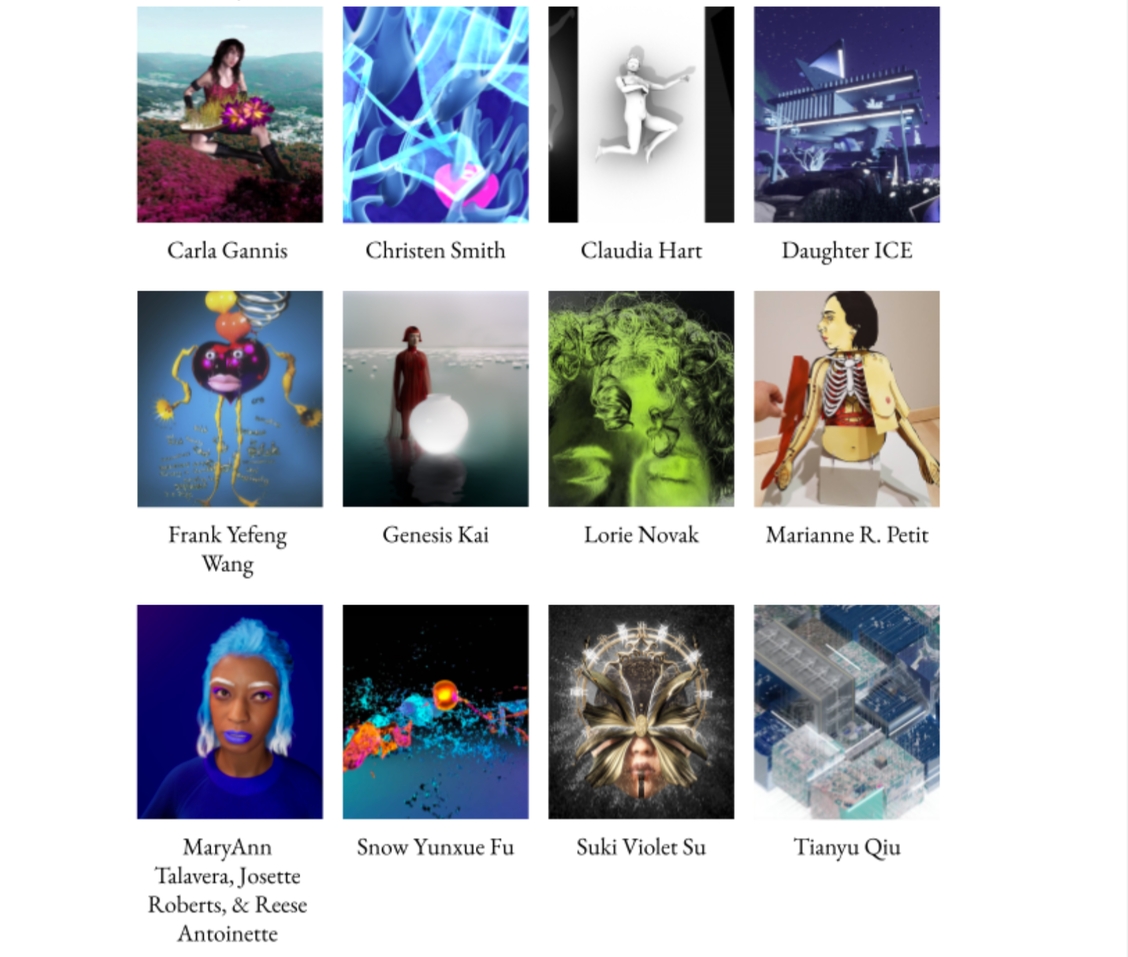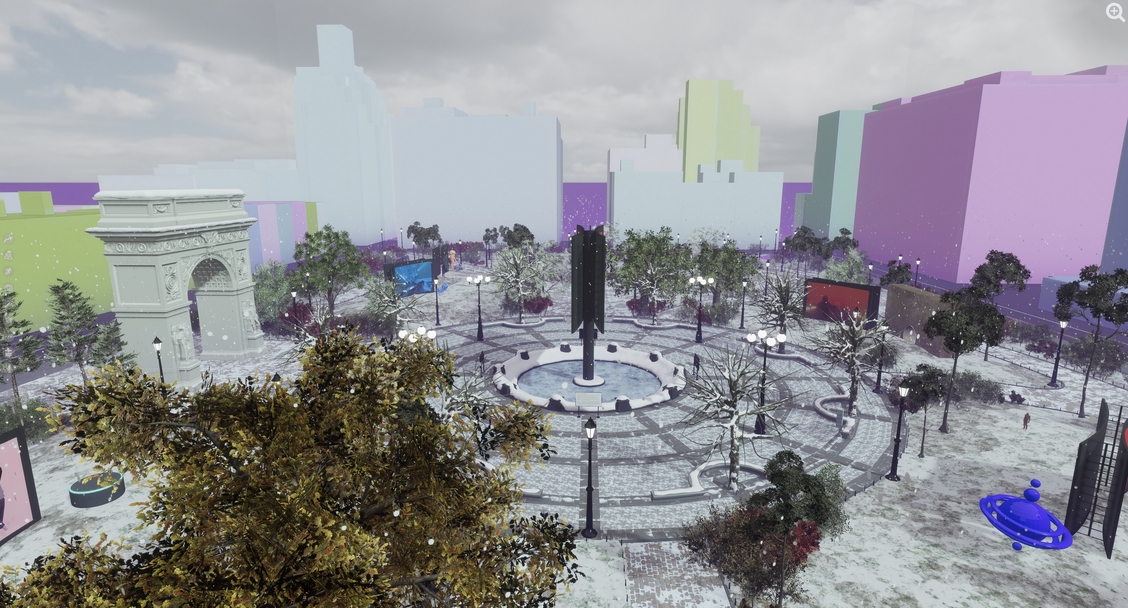VR WSPark Spring 2023 Exhibition - Sheng 生

Metaverse Exhibition Title: Sheng 生 (Life, Living, Birth, & Lives)
Exhibition Link: The Web 3 link will be accessible on the opening day
Opening Time: Friday, 04/07/2023
Curators: Snow Yunxue Fu & Daughter ICE
Exhibition Venue: VR WSPark
Co-host: DSLCollection
Exhibition Arts Writer: Natasha Chuk
Online Artist Talks Events: The online live artist talks and events will be held in the following weeks in April and May.
Exhibition Concept:
Sheng (生) is a Web 3 exhibition taking place in the virtual exhibition space, VR WSPark, hosted on the social VR platform, Sansar, in spring 2023. Sheng (生) is curated by the digital human, Daughter ICE, and her progenitor, New Media artist Snow Yunxue Fu. The exhibition is co-hosted by the DSLCollection.
Sheng (生) is the Chinese character for life (人生), living (生活), birth (出生), and Lives (生命). The artworks in this group exhibition explore these concepts and their implications in the context of existence in digital spaces and the Metaverse, and virtual beings created with imaging technologies.
Exhibiting Artists:
Carla Gannis, Christen Smith, Claudia Hart, Daughter ICE, Frank Yefeng Wang, Genesis Kai, Josette Roberts, Lorie Novak, Marianne R. Petit, MaryAnn Talavera, Reese Antoinette, Snow Yunxue Fu, Suki Violet Su, Tianyu Qiu, Xiaobing Liu, Yuge Zhou, and Ziqiong Huang

thumbnail images of artists' work that will be on display online
Exhibition Hosts:
VR WSPark is a Web 3 cosmopolitan park resembling NYC’s Washington Square Park, presented on the Social VR Platform Sansar. It is run by Snow Yunxue Fu, Artist, Curator, and Professor at NYU Tisch School of the Arts Department of Photo and Imaging, co-hosted by DSLCollection. It showcases curated exhibitions by the NYU communities and beyond, and also functions as a virtual cultural hub for additional events, lectures, and shows in the metaverse.
DSLCollection is a private collection that was founded by Dominique and Sylvain Levy in 2005. It comprises works of the early Chinese avant-garde and recent contemporary works. The collection is conceived as a project, actively seeking artists who inscribe themselves in contemporary discourse and, in their works, reflect the increasingly globalized state of the world at large from a Chinese perspective.

VR WSPark
Exhibition Essay:
SHENG 生
by Natasha Chuk
In Snow Yunxue Fu’s Conjoin (Chapter 3) (2018), an animation of abstract, fluid bodies move in a meditative, perpetual motion. The circular rhythm and disintegration of forms signal the aqueous, shifting, vertiginous but intimate and interdependent relationship between our corporeal and digital existence, as well as our physical and virtual connection to others. It’s a looping, ruminative moment in this group exhibition, which underscores the show’s overarching theme. Sheng 生, the Chinese character for life, living, birth, and lives, is a group exhibition curated by new media artist Snow Yunxue Fu and her digital human Daughter ICE. It features seventeen participating artists whose work probes and reimagines experiences of familial relations, legacies, memory, bodies, and existence across physical, biological, digital, and spiritual domains. The show is set in a metaverse exhibition space modeled on the physical, NYU-adjacent Washington Square Park called VR WSPark, which was created by Fu and is co-hosted by DSLCollection.
As co-curators, Fu and Daughter ICE incorporate an intergenerational storytelling approach to the concept of Sheng 生 and seek virtual pathways for cultivating family relationships, digital legacies, and borderless communal experiences. Fu’s own exploration of digital humanhood by giving life to a digital entity in Daughter ICE, a digital human with agency and independence, is a gesture toward building a virtual family and home. Daughter ICE’s metaverse-based residence Running Island Floating Island (2023) is a virtual hub where family and friends can meet anytime and from anywhere in the world. Fu’s work and the virtual home are placed in conversation with woodcut prints made by Fu’s mother Xiaobing Liu and grandmother Ruiqiong Huang. Liu’s Thoughts on the City (1986) reflects on the increased modernization and transformation of China, and Huang’s TV in a Miao Village (1982) shows a group of villagers in China, who gather around the only TV in the community. Each artist used an inking technique invented by Zhonghe Liu, Fu’s grandfather. Together, the four worksrepresent four generations of women linked by family heritage, motherhood, and craft, illustrating a genealogy of creative influences, techniques, and personal style.
Across several works, we experience how the power of mythologies is revealed, engaged, and retold through digital beings who seek out, draw on, and interpret their ancestral influences. In Pretty Poly (2017), Carla Gannis recreates a childhood memory of her family’s shared experience of storytelling through song and instrumentation. Invoking her avatar, Gannis playfully reimagines herself as the murdered Polly in the original folk ballad, who is revamped into a confident polymath who zips through space and time using her dulcimer-shaped rocket. Frank Yefeng Wang’s The Whimsical Characters (Groundless Protag) (2019—) is an infinitely looping experimental 3D animation that addresses the chaotic in-betweenness of a multicultural identity formed by migration, originary estrangement, and cultural negotiation. A selection of works by virtual human artist Genesis Kai offers fresh interpretations of cultural heritage and alternative states of existence. Manifest (2021) is a performative reenactment that tells the story of Genesis Kai’s digital birth from a digital womb. The Red Prayer Of Park Young Sook’s Moon Jar (2023) takes inspiration from Korean ceramicist Young Sook Park’s iconic Moon Jar, an elegant object that communicates weightless heft. Here, the digital moon jar is represented as a glowing celestial body, evoking lunar prayer, hope, and waiting in anticipation for life to form. ORIXA: Planet Aris (2022) is a monologue written by Josette Roberts in collaboration with The ORIXA Project, a mixed reality experience inspired by the Orishas and Black womxn of the African diaspora, led by interdisciplinary artists MaryAnn Talavera and Reese Antoinette. Delivered by the digital human MJ, the soliloquy ruminates on the polysemous nature of what a mother is: ranging from life, to death, to the essence of us all.
Several works probe the ways identities are expressed, the emergence of liminal states, and the experience of dreamlike imaginary landscapes. Claudia Hart’s Recumulations (2010/19) is a work placed in dialogue with Trisha Brown’s dance choreography for Accumulations (1971) via a live recreation by performance artist Roberto Sifuentes in 2011, which Hart recorded, then mapped his movements onto a 3D model to create a new form of digital existence. Through a process of combination, interpretation, and translation, a cyborg choreography emerged and is expressed by a racially and gender fluid digital being. Lorie Novak’s Migraine Register (2009—) is a series involving self-presentation and the use of a camera as a witness to the body’s invisible experiences. Focusing on Novak’s face, the images accumulate to form a visual diary and translator of pain, disorientation, and chronic suffering. Suki Violet Su’s SKINSEQ-Dreaming (2022), inspired by the ancient philosopher Zhuang Zhou’s dream of becoming a butterfly, also focuses on the face, interpreting it as a site where individual expression and the consciousness of the universe converge.
Christen Smith’s abstract animation Ofeelia at the Moment of Consciousness Before HerRebirth (2023) subverts Shakespeare’s tragic heroine Ophelia by imagining what it might look like to heal and reconstruct a broken soul, body, mind, and heart. The body’s sublime internal magnificence is brought to the surface in Marianne R. Petit’s Breath (2016). The work is inspired by her time spent in Shanghai and the fascination she developed with both the daily Air Quality Index and our body’s capacity to endure physical threats. Tianyu Qiu demonstrates the relations between geographies, maps, and perception in an age of information excess and competing information flows. Fragmented Reality (Ukraine, Korea, Peninsula, Okinawa, Shanghai) (2022) organizes places into multilayered blocks using satellite image maps from Google Earth, situating a place’s topographic accuracy in conflict with the ambiguity of preconceived notions, rumors, and media headlines about the places in question. Yuge Zhou’s Moon Drawings (2022) is a video that pairs the rhythm of ritual with the uncertainty of postponement. Since 2020, the artist has been restricted from traveling from the United States to her homeland of China. Inspired by the Chinese tradition of a full moon symbolizing family reunion, Zhou figuratively brings the moon to her by tracing its shape in snow with her suitcase, a ritual she will continue for as long as her trip home is delayed.
The themes of family, ancestry, hybrid forms, and liminal experiences course through the work in Sheng 生 as biological connections, relationships between humans and non-human others, and imaginary states of existence. Sheng 生 encourages us to consider the breadth of possibilities for our increasingly hybrid world, the potential for digital humanhood and intimacy, and the significance and relevance of our elders in contemplating and building our futures. Underlying the works on view is a noticeable network of kinfolk: artists as peers, mentors, mentees, colleagues, collaborators, and close friends who nurture each other across generations, creative sensibilities, and seasons of change. In Sheng 生, the complexity and cyclical nature of creativity and the basis of our existence are entwined, collectively expressed through the artwork, the artists, and the hybrid environment of VR WSPark.